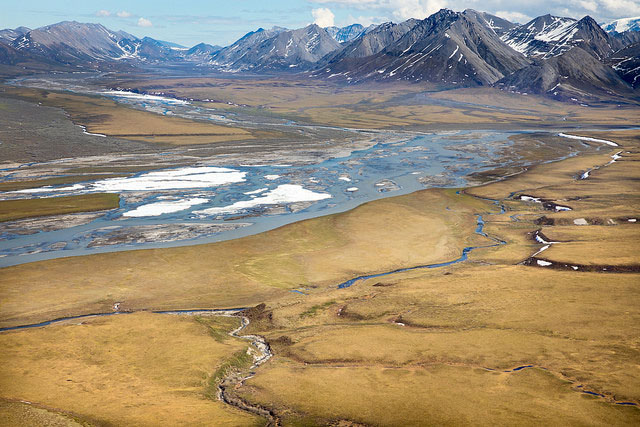
A year after Congress voted to allow oil development in the Arctic National Wildlife Refuge, the Trump administration is taking another step towards making it happen.
The Interior Department announced Thursday that it’s releasing the draft environmental review for the planned oil leasing sale in the refuge’s Coastal Plain.
“An energy-dominant America starts with an energy-dominant Alaska,” outgoing Interior secretary Ryan Zinke said in a statement.
Alaska leaders celebrated the step, which keeps Interior on track to hold a lease sale next year. But it was immediately condemned by environmental groups, which issued statements blasting the over 700-page draft within minutes of its release. They say it threatens polar bears, migratory birds, the Porcupine caribou herd and other species that live in the Refuge.
When finalized, the environmental review will guide where and how oil leasing should happen in the Coastal Plain, also known as the 1002 area. It makes up 1.6 million acres in the 19-million-acre refuge.
“Alaskans have anticipated the release of the draft environmental statement for decades,” Gov. Mike Dunleavy said in a statement. “We are eager to inform and educate our fellow Americans that it will be done utilizing the highest environmental standards and safeguards to protect its land, waters and wildlife.”
In a call with reporters before the review’s release, top Interior official Joe Balash — a former Alaska commissioner of natural resources — said he is looking forward to the results of an oil lease sale.
“There aren’t many basins on the planet where we have a very high degree of confidence that there’s significant hydrocarbons that haven’t been explored yet,” Balash said. “There’s going to be, we expect, significant industry interest in being a part of finding out what’s there.”
Balash said that the oil leasing options in the draft protect the Porcupine caribou herd’s calving habitat.
He also stressed that Interior consulted with Alaska Native communities while writing the draft. He said he personally met with Gwich’in representatives in the village of Venetie, from whom, he said, “I could not have received a warmer greeting.”
“My message to them was straightforward: that I was not there to convince them, I was not there to change their minds,” Balash said, “But I wanted to know everything they could share to help us craft a better plan than we would without them.”
The vulnerability of the Porcupine caribou herd is one of the main reasons conservation groups and Alaska Native Gwich’in people oppose oil development in the refuge. They argue any oil drilling there threatens the herd.
Those groups expressed immediate alarm about the leasing program spelled out in the draft. Lois Epstein with the Wilderness Society in Anchorage said she was surprised by how much acreage could potentially be put up for oil leasing.
“In no way can we argue that this is going to be protective of the wildlife there,” Epstein said. “The caribou that arrive there every summer after they’ve been calving are going to encounter enormous amounts of infrastructure. It’s devastating.”
Alternatives laid out in the draft envision nearly all of the 1.6 million-acre coastal plain being offered for oil leasing. But at any given time, no more than 2,000 surface acres could contain infrastructure.
Epstein said environmental groups are waiting until the final record of decision on the oil leasing program is released to pursue potential legal action. But Epstein added their ultimate goal is to convince Congress to reverse its decision to allow drilling in the refuge.
“What we’re doing now is trying to limit the damage before that can occur,” Epstein said.
In the 2017 tax cut legislation, Congress required that each lease sale in the Coastal Plain should offer “not fewer than 400,000 acres” up for bid to oil companies.
A 45-day public comment period on the draft starts December 28.
This post has been updated.
